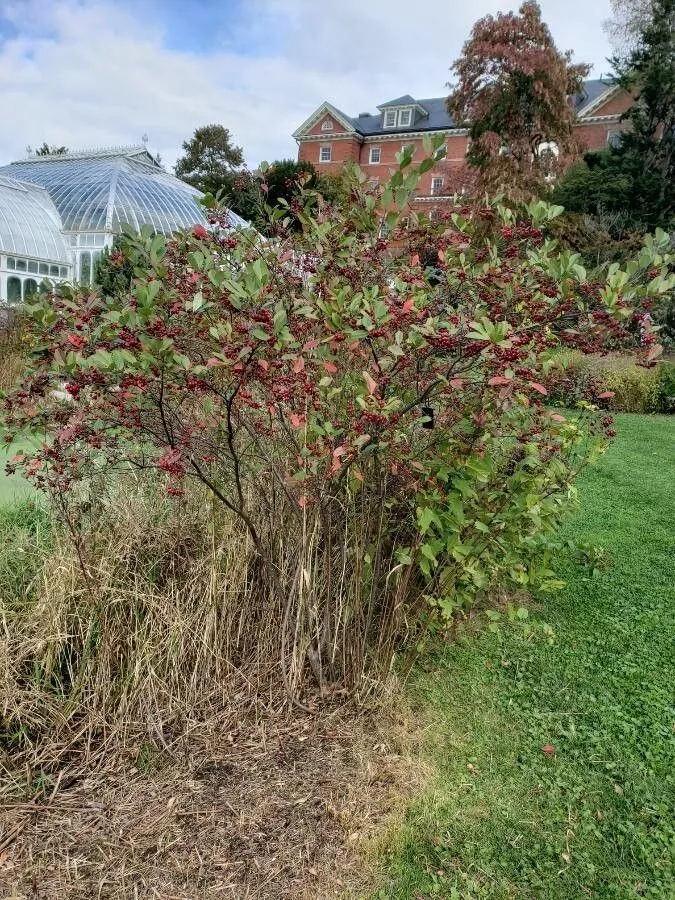
Author: (L.) Pers.
Bibliography: Syn. Pl. 2: 39 (1806)
Year: 1806
Status: accepted
Rank: species
Genus: Aronia
Vegetable: False
Observations: E. Canada to C. & E. U.S.A.
The Red chokeberry, known scientifically as Aronia arbutifolia, is a vibrant, deciduous shrub that belongs to the Rosaceae family. This plant is a noted survivor and inhabitant of the varied climates spanning from Eastern Canada to the Central and Eastern United States, making it a well-established species in North American flora.
Characterized by its stunning red berries, the Red chokeberry provides both ornamental and ecological value. In the autumn, the shrub undergoes a dramatic transformation, with its foliage turning bright red, making it a spectacular addition to any landscape. The berries, although tart and astringent, serve as a critical food source for birds and wildlife, especially during the leaner winter months. Despite their sharp taste, these berries can be processed into a variety of jams, jellies, and wines, attracting culinary interest for those willing to harness their unique flavor profile.
In gardens and natural settings, the Red chokeberry is often appreciated for its low maintenance and high adaptability. It thrives in well-drained soils but is also tolerant of both wet and dry conditions, allowing it to flourish in diverse environments. Furthermore, it shows a good level of resistance to pests and diseases, making it a robust choice for gardeners looking to add resilient beauty to their plant collections.
Red chokeberry’s role extends beyond mere aesthetics. The plant contributes significantly to local ecosystems by providing habitat and sustenance for various species. Its flowers, which bloom in the spring, offer nectar for pollinators, including bees and butterflies, thereby supporting the broader ecological web.
While the visual appeal of Aronia arbutifolia is undeniable, the plant also engages with the historical and botanical communities through its mention in scientific literature. As early as 1806, it was documented in reputable texts, ensuring its place in both scientific and practical horticulture.
In conclusion, the Red chokeberry is a multifaceted shrub that pairs hardiness with beauty, and ecological benefit with simplicity in care. Its presence across a wide geographical range underlines its adaptability and the important role it plays in both natural and cultivated areas.
Dan: brunfrugtet surbær, klarbundbladet abild
Eng: red chokeberry
Deu: rotfrüchtige apfelbeere, filzige apfelbeere
Fra: aronia à feuilles d’arbousier, aronie à feuilles d’arbousier
Swe: rödaronia, röd aronia
Nno: raudsurbær
Nob: rødsurbær
Cym: llwyn aeron tagu coch, llwyn aeron tagu cochion
Nld: rode appelbes
En: Red chokeberry
Bg: Червена арония
Zh: 紅山楸梅
Da: Brunfrugtet surbær, Klarbundbladet abild
Nl: Appelbes, Rode appelbes
Eo: Felta aronio
Fi: Puna-aronia
Fr: Aronia à feuilles d’arbousier, Aronie à feuilles d’arbousier, Aronia à fruits rouges, Aronia rouge
De: Filzige Apfelbeere, Rotfrüchtige Apfelbeere, Rote Apfelbeere
Ko: 붉은아로니아
Nb: Rødsurbær
Nn: Raudsurbær
Fa: انگورک گلوگیر سرخ
Ru: Арония красная
Sk: Arónia jahodovolistová
Sv: Rödaronia, Röd aronia
Cy: Llwyn aeron tagu coch, Llwyn Aeron Tagu Cochion
Taken Jul 29, 2021 by landry bertaux (cc-by-sa)
Taken Oct 15, 2020 by C. Ashley (cc-by-sa)
Taken Oct 15, 2021 by Jikki Masu (cc-by-sa)
Taken Aug 11, 2022 by bryan brunet (cc-by-sa)
Taken Aug 22, 2022 by Jean-yves Gautreau (cc-by-sa)
Taken Oct 9, 2022 by Henri Hazzan (cc-by-sa)
Taken Oct 31, 2021 by Jasper Edwards (cc-by-sa)
Taken Oct 12, 2020 by Claudia R (cc-by-sa)
Taken Oct 18, 2022 by April Green (cc-by-sa)
Taken Nov 1, 2022 by Babette Novak (cc-by-sa)
Taken Oct 22, 2021 by William Coville (cc-by-sa)
Taken Nov 19, 2022 by dassori paul (cc-by-sa)
Taken Apr 7, 2022 by vidclip (cc-by-sa)
Taken May 29, 2021 by pierrecolin (cc-by-sa)
Taken May 8, 2022 by Matthias Foellmer (cc-by-sa)
Taken Aug 17, 2019 by that’s someguy (cc-by-sa)
Taken Jan 16, 2021 by Diego Alex (cc-by-sa)
Growth habit>: Shrub,
Family: Myrtaceae Author: (F.Muell.) K.D.Hill & L.A.S.Johnson Bibliography: Telopea 6: 402 (1995) Year: 1995 Status:…
Family: Rubiaceae Author: Pierre ex A.Froehner Bibliography: Notizbl. Bot. Gart. Berlin-Dahlem 1: 237 (1897) Year:…
Family: Sapindaceae Author: Koidz. Bibliography: J. Coll. Sci. Imp. Univ. Tokyo 32(1): 38 (1911) Year:…
Family: Asteraceae Author: A.Gray Bibliography: Pacif. Railr. Rep.: 107 (1857) Year: 1857 Status: accepted Rank:…
Family: Fabaceae Author: Medik. Bibliography: Vorles. Churpfälz. Phys.-Ökon. Ges. 2: 398 (1787) Year: 1787 Status:…
Family: Aspleniaceae Author: (Cav.) Alston Bibliography: Bull. Misc. Inform. Kew 1932: 309 (1932) Year: 1932…